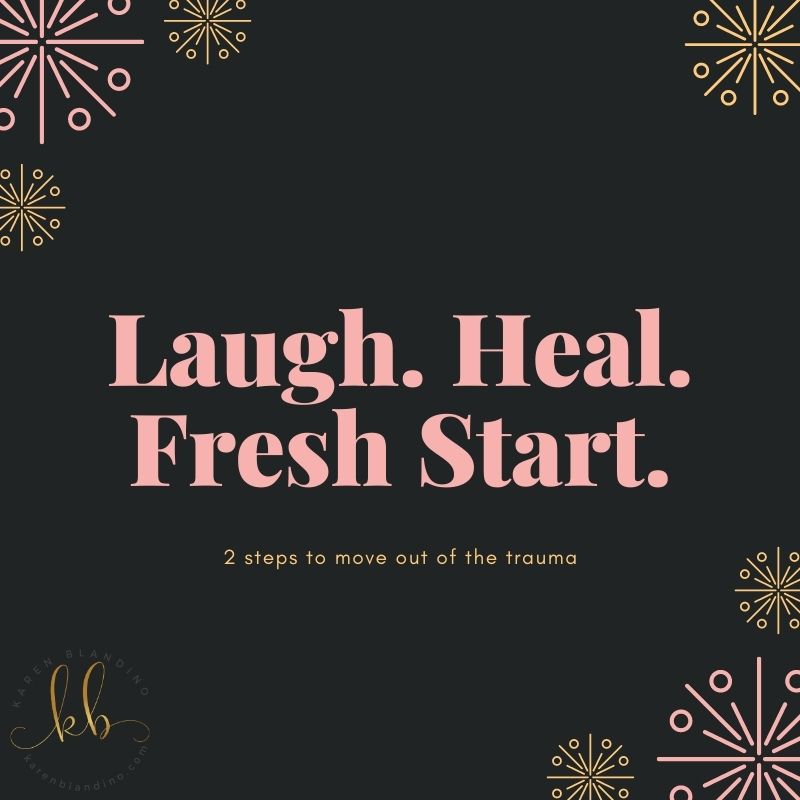2 steps to move out of 2020
When I look at my pictures from our New Year’s Eve party from 2019 — as we prepared to ring in 2020 – it is like looking at the unnatural calm before the storm. If someone had told me what would happen in the next few month, I’m not sure I would have believed them. I tend to lean towards the hopeful, that a new year is like a fresh start. It’s a new beginning, and things will only get better . Even through years of church struggles, family cancer diagnosis, my husband’s heart failure, I still try to believe that it could only get better. It has to get better.
Unfortunately, 2020 had other plans that none of us were privy to. The trauma endured during 2020 could fill libraries with stories of difficulties, struggles, hardships and grief from people like you and me. As happy as I was to ring in 2021, I know this does not magically remove the suffering endured during 2020 or its lingering traumatic effects we are still enduring in 2021.
In fact, trauma has a way of re-manifesting itself on people. Simply put, as a person recalls a traumatic incident, they will “relive” the emotions like the trauma just occurred. Until the person finds healing from the trauma, the emotional trauma can occur over and over. It is like living life on a tight rope, every memory shakes the rope causing fear and anxiety to well up again as you try to maintain your balance on the wire.
So how do we close this cycle? How do we find healing or closure from the trauma?
I want to share a couple of thoughts on how to start the healing process. These are not the end all to trauma healing. Healing is unique to every person and it takes times. These two thoughts are more like baby steps to orient yourself in the direction towards healing.
Laugh
First, rekindle your laughter. Unfortunately, the effects of trauma can take away your smile and laughter, leaving you with feelings of despair or hopelessness. Laughter is a beautiful, natural remedy. Proverbs 17:22 says, “A joyful heart is good medicine, but a crushed spirit dries up the bones.”
Laughter helps release your endorphins – those feel good emotions that can decrease stress and pain in the body. Re-watch an old show, have dinner with a fun friend, or do something that you know makes you smile and laugh.
We are designed for joy. We are created to smile. We are formed with laughter in our bones.
Question
The second step is a bit harder, and you may not be feel ready for it. I want to encourage you to reflect on it even if it is uncomfortable.
Ask your trauma, “What have you come to teach me?”
This is more of a mind shift. It is a hard shift to how we like to think about pain. When both of my parents were experiencing severe cases of COVID-19, I was scared. I worried that I was going to lose both of my parents, and the feelings of pain broke my heart. I remember telling my husband “I am not strong enough for this, and I don’t know how to deal with this pain”.
For the next couple of hours, I wept, prayed, and worshipped. I believe my tears spoke most of my prayers that night. What did my pain eventually teach me during this? It reminded me that Jesus is close to the brokenhearted. It showed me that in my weakness I am still strong. Even in the journey of not knowing the outcome, the peace of God was (and is) my comfort.
Writing these words today may make this step seem easy. When my husband first shared this quote with me, I had a hard time accepting that I was ready to learn from the experience. I think sometimes we can find a false comfort in our trauma, not realizing that it is preventing us from growing.
I am still believing that 2021 will be good. Although I do know that I may experience some pain, I feel better prepared to smile, laugh, and face any hardship with a bold question: “What have you come to teach me today?”



Karen,
Thank you for framing my thoughts and giving me encouragement as I struggle to make sense of the chaos that started with 2021. Thank you.
I am so happy you read the article. I pray it will be start for you!
This is awesome. Love you baby
Thank you Mom – It means so much that you read this!
Beautifully said! No matter how old we are, we have to be reminded that we can still learn from even the most difficult of circumstances. Blessings.
Thank you so much for reading! Yes, we are never to old to learn!
I love this. I am focusing on finding the joy and laughter even though life has thrown many curve balls over the last couple of years and continues to do so. I continually pray for the Lord to “show me and grow me” through the hard times and your words are a great reminder for perseverance in that. Thank you for sharing your heart Karen♥️
Thank you for reading Courtney! Yes, we are all on that journey!
You put things beautifully in perspective. WE all need to read perspectives like yours to remind us of hope and who in ultimately in control. Thanks for my reset.
Thank you for reading Tracey!
This really spoke to me today. I always enjoy reading your stuff! So encouraging! Please keep them coming! ❤️❤️❤️
Miss you Kourtney!!
Cousin Karen,
May life bring you a reflection of kindness you’ve shown to others. Thank you for your encouraging words of wisdom we all needed to hear especially in these hard times we are all going through. There has been so many known lives taken from us through Covid and words cannot Express the hurt we feel right now. It’s a comfort to know we can count on each other through whatever life brings. Thank you, your kind words touched my heart
Cousin Evie
We are praying for you guys! Our hearts are with you during this time. Love your cousin!